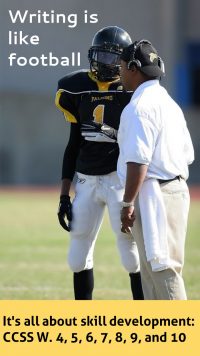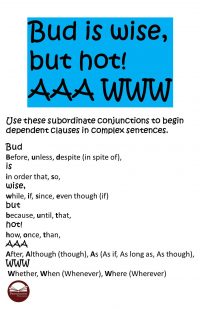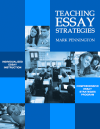The “Reading Wars” and “Writing Wars” have preoccupied educational researchers and teacher-practitioners for nearly five decades. Much like the soldiers along the Western Front in World War I, we have settled down into our fixed positions and rarely leave our trenches to skirmish anymore. An occasional Krashen or Adams volley may occasionally wake us up, but no one really wants to go back into “No Man’s Land” for extending fighting. In fact, much of where we are today reminds me of the scene from All Quiet on the Western Front, in which the opposing German and British soldiers join in the singing of Christmas carols and crawl out of their trenches to exchange gifts and greetings.
Now I may be over-extending my metaphor a bit, but teachers see more value today in an eclectic approach to teaching reading and writing. We embrace both part-to-whole and whole-to-part instruction. No one wants to throw away the explicit teaching of phonemic awareness/phonics or reading to learn; no one wants to throw away explicit grammar, spelling, and writing strategies instruction or the writing process with Writers Workshop. In a previous article, I have made the case that a balanced reading program makes sense. In this article, I will attempt to make the case that a balanced writing program also makes sense. First, I will list 21 Curricular Assumptions that most of us would accept about writing instruction to build a consensus. Then, I will detail six steps to take to ensure a balanced and effective writing program in any classroom.
Most of us would agree with these… 21 Curricular Assumptions about a Science of Writing Program
1. Teaching and practicing the stages of the writing process through writing process papers in various genre is important. The writing process is not rigid, however. Writers compose differently. Word processing has certainly reinforced these differences. For example, some revise and edit after drafting; some do so during drafting.
2. Teaching and practicing specific writing strategies/skills in short writing pieces, such as “Quick Writes,” is also valuable.
3. Students vary in their writing abilities and have different writing skill-sets. Simply teaching grade-level standards in writing strategies and applications (process pieces) is not enough. Certainly, we teach content, but we also teach students. We need to both “keep them up” with grade-level expectations and new instruction and also “catch them up” with additional targeted practice in their writing deficiencies. Teachers see the value in diagnostic assessments to determine who does and does not need extra instruction and in which writing skills. Yes, we need to differentiate our writing instruction.
4. The reading-writing connection much be taught explicitly. We learn reading from writing, but we also learn writing from reading. For example, teaching expository text structure is both reading comprehension and an essay strategy. Analyzing both good and bad writing is instructive.
5. Good writing instruction is necessarily “recursive.” Students need to review, but also do new. As teachers review, writing foundations are solidified and depth of understanding increases. For example, first graders work on sentence construction, but so should high school seniors.
6. Teaching content is an essential ingredient to teaching writing. Writing is a constructive thinking process, built on prior knowledge. Time spent teaching critical thinking skills, such as errors in reasoning, is time spent teaching writing.
7. Vocabulary development is an important component of writing instruction. Knowing the meanings of words and how to properly use them cannot be confined to a revision task such as substituting boring or over-used words with “cool words” found in a thesaurus. Teaching Greek and Latinates, semantic shades of meaning, idiomatic expressions, etc. are all components of solid writing instruction.
8. Explicit grammatical instruction (sentence components, word choice, usage, word order) should be more than just error analysis or correction. Daily Oral Language is certainly not the answer. Teaching grammar and mechanics rules/proper usage in the context of targeted lessons that integrate this instruction with student writing is appropriate. For example, teaching a prepositional phrase and then following instruction with writing practice in which students use prepositional phrases as grammatical sentence openers makes sense. Grammar and mechanics cannot exclusively be relegated to end of writing process as mere editing skills.
9. Spelling matters and requires direct instruction, even throughout high school. The spelling-vocabulary connection is well-established and needs to be taught in the context of word study (including derivatives and etymological influences), syllabication, and conventional spelling rules. Spell check did not suddenly make orthographical study passé.
10. Revision is the key to writing improvement. Revision requires direct instruction to teach sentence manipulation, sentence combining, sentence variety, and precision of word choice. Revision requires focused tasks in the writing process to add, delete, substitute, and rearrange ideas to afford writers alternative means of expression. Hemingway completely re-wrote the last chapter in For Whom the Bell Tolls in 39 different ways. There must be something to this revision stuff.
11. Authentic writing tasks that are relevant and meaningful to students motivate quality writing, especially when the writing will be published in a venue that students care about.
12. Teaching rhetorical stance: voice, audience, purpose, and form produces significant writing pay-offs. Writing style can be modeled, mimicked, and developed over time.
13. Degree of oral proficiency in vocabulary and grammar impacts writing ability. ESL students need differentiated instruction to bridge language barriers.
14. Direct instruction is not enough—coaching is necessary to teach students how to write. The “sage on the stage” has to be matched with the “guide on the side.”
15. Teaching structured writing makes sense to focus on writing organization and unity. However, form and purpose dictate structure, so structural straight-jackets can be counter-productive, if pressed into service for every writing task.
16. There are certain writing rules that are worth teaching. Of course, rules are specific to each writing form. Indenting paragraphs, writing in complete sentences, and the like add to writing coherency.
17. Writing coherency should be the ultimate goal of any writing task.
18. Teaching grammar, spelling, vocabulary, and writing strategies are more than just test prep. These skills require teaching and practice, not testing. Fortunately, quality instruction and practice in these writing components will result in higher test scores.
19. What we say shouldn’t always be the way that we write. Good writing instruction helps students learn to distrust their oral language as a grammatical filter. Authentic writing voice is not the same as playground banter.
20. Writing fluency is a worthy goal; however, contrived on-demand writing for the purpose of writing lots of words in a given time does not achieve that end.
21. Teaching writing shouldn’t take up an entire English-language arts course. We have other fish to fry as well.
How to Teach a Science of Writing Program in Six Steps
1. Develop a Writing Plan
Establish a comprehensive writing scope and sequence of instruction with your colleagues, including those who precede and those who follow you. Base your plan on your more general grade-level state standards, but get as specific as possible. I suggest integrating grammar, mechanics, spelling instruction, specific writing strategies, writing genre, and writing process pieces into a multi-year plan. An specific writing scope and sequence makes more sense than a “shotgun” approach.
2. Direct Grammar/Mechanics/Spelling Instruction
Allocate 15 minutes, 2 days per week, to direct instruction of the grammar, mechanics, and spelling skills dictated by your scope and sequence, say on Tuesdays and Thursdays. Find resources that will teach both sentence modeling and error analysis. Require students to practice what has been learned and formatively assess their skill acquisition.
3. Differentiated Grammar/Mechanics/Spelling Instruction
Use an effective diagnostic assessment to identify grammatical and mechanical skills that your students should already know. Also, assess students on their spelling skills. Chart their deficits and find brief, targeted instruction that students can independently practice. Develop brief formative assessments for each skill. Allocate 15 minutes, 2 days per week, of teacher-student mini-conferences to review their practice and grade their formative assessments, say on Wednesdays and Fridays. Have students keep track of their own mastery of these skills on progress monitoring charts. Re-teach and re-assess skills not-yet-mastered.
4. Do Direct Writing Instruction
Allocate 10 minutes, 3 days per week, to direct instruction, sentence models, and guided writing practice in vocabulary development and sentence revision (sentence manipulation, sentence combining, and sentence variety) say on Mondays, Wednesdays, and Fridays. Require students to practice what has been learned and formatively assess their skill acquisition.
5. Do Differentiated Writing Instruction
Allocate 15 minutes, 2 days per week, to direct instruction of the writing strategies/skills dictated by your scope and sequence, say on Tuesdays and Thursdays. Design paragraph assignments to keep writing and review time manageable. Develop brief formative assessments for each skill. Allocate 15 minutes, 3 days per week, of teacher-student mini-conferences to review their practice and grade their formative assessments, say on Mondays, Wednesdays, and Fridays. Have students keep track of their own mastery of these skills on progress monitoring charts. Re-teach and re-assess skills not-yet-mastered.
6. Teach Process Papers
Teach and require students to compose at least one process paper per quarter, as dictated by your scope and sequence and grade-level standards. Not every process paper must include all steps of the Writing Process.
*****

TEACHING ESSAYS BUNDLE
The author’s TEACHING ESSAYS BUNDLE includes the three printable and digital resources students need to master the CCSS W.1 argumentative and W.2 informational/explanatory essays. Each no-prep resource allows students to work at their own paces via mastery learning. How to Teach Essays includes 42 skill-based essay strategy worksheets (fillable PDFs and 62 Google slides), beginning with simple 3-word paragraphs and proceeding step-by-step to complex multi-paragraph essays. One skill builds upon another. The Essay Skills Worksheets include 97 worksheets (printables and 97 Google slides) to help teachers differentiate writing instruction with both remedial and advanced writing skills. The Eight Writing Process Essays (printables and 170 Google slides) each feature an on-demand diagnostic essay assessment, writing prompt with connected reading, brainstorming, graphic organizer, response, revision, and editing activities. Plus, each essay includes a detailed analytical (not holistic) rubric for assessment-based learning.
Get the Writing Process Essay FREE Resource:

Grammar/Mechanics, Reading, Spelling/Vocabulary, Writing
balanced writing, daily oral language, how to teach writing, Science of Writing, sentence combining, Six traits, step up to writing, structured writing, Teaching Essay Strategies, teaching essays, teaching grammar, teaching spelling, teaching vocabulary, writers workshop, writing process, writing strategies











